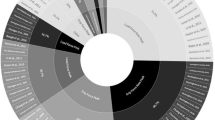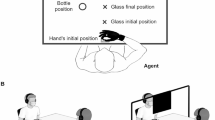Abstract
We studied possible frames of reference for kinesthetic perception of imposed hand motion direction in the frontal plane in ten young adult subjects with no history of neuromuscular disease. In one experiment, subjects were instructed to set unseen hand motion imposed by a motorized linear slide device parallel to the trunk-fixed longitudinal axis, seven visually specified axes and vertical (gravitational axis) while in a standard erect head/trunk posture and with head/trunk orientation varied. The visually specified axes were presented on a head-mounted display that also blocked vision of the external environment. In a second experiment using the same device, subjects set unseen hand motion parallel to vertical and to subjective oblique directions of 45° clockwise (cw) and counter clockwise (ccw) from vertical in erect and varied head/trunk postures. Errors for setting hand motion to vertical and to verbally specified oblique axes (45° cw and ccw from vertical) were lower than to the trunk longitudinal axis and visually specified axes. There were clear oblique effects in setting hand motion to visually specified axes and to subjective oblique (45° cw and ccw) axes. When head and trunk orientation were varied, variable errors were higher for all axes, but remained lowest for vertical and subjective oblique axes. Moreover, errors for setting hand motion to all axes depended on head/trunk orientation. Overall, these results show that kinesthetic perception of imposed hand motion uses a subjective gravitational frame of reference that varies somewhat with head/trunk orientation.








Similar content being viewed by others
References
Appelle S (1972) Perception and discrimination as a function of stimulus orientation: the “oblique effect” in man and animals. Psychol Bull 78:266–278
Baud-Bovy G, Gentaz E (2006) The haptic reproduction of orientations in three-dimensional space. Exp Brain Res 172:283
Baud-Bovy G, Viviani P (2004) Amplitude and direction errors in kinesthetic pointing. Exp Brain Res 157:197–214
Bouma H, Andriessen JJ (1968) Perceived orientation of isolated line segments. Vision Res 8:493–507
Collins DF, Refshauge KM, Todd G, Gandevia SC (2005) Cutaneous receptors contribute to kinesthesia at the index finger, elbow, and knee. J Neurophysiol 94:1699–1706
Darling WG (1991) Perception of forearm angles in three-dimensional space. Exp Brain Res 87:445–456
Darling WG, Bartelt R (2003) Kinesthetic perception of visually specified axes. Exp Brain Res 149:40–47
Darling WG, Bartelt R (2005) The visual perception coordinate system uses axes defined by the Earth, trunk, and vision. Perception 34:17–30
Darling WG, Hondzinski JM (1999) Kinesthetic perceptions of earth- and body-fixed axes. Exp Brain Res 126:417–430
Darling WG, Miller GF (1993) Transformations between visual and kinesthetic coordinate systems in reaches to remembered object locations and orientations. Exp Brain Res 93:534–547
DiZio P, Lackner JR (2000) Congenitally blind individuals rapidly adapt to coriolis force perturbations of their reaching movements. J Neurophysiol 84:2175–2180
Flanders M, Soechting JF (1995) Frames of reference for hand orientation. J Cogn Neurosci 7:182–195
Gandevia SC, Smith JL, Crawford M, Proske U, Taylor JL (2006) Motor commands contribute to human position sense. J Physiol (Lond) 571:703–710
Garrett SR, Pagano C, Austin G, Turvey MT (1998) Spatial and physical frames of reference in positioning a limb. Percept Psychophys 60:1206–1215
Gentaz E, Hatwell Y (1999) Role of memorization conditions in the haptic processing of orientations and the ‘oblique effect’. Br J Psychol 90:373–388
Gourtzelidis P, Smyrnis N, Evdokimidis I, Balogh A (2001) Systematic errors of planar arm movements provide evidence for space categorization effects and interaction of multiple frames of reference. Exp Brain Res 139:59–69
Hall LA, McCloskey DI (1983) Detections of movements imposed on finger, elbow and shoulder joints. J Physiol 335:519–533
Haun DB, Allen GL, Wedell DH (2005) Bias in spatial memory: a categorical endorsement. Acta Psychol (Amst) 118:149–170
Henriques DY, Soechting JF (2005) Approaches to the study of haptic sensing. J Neurophysiol 93:3036–3043
Huttenlocher J, Hedges LV, Corrigan B, Crawford LE (2004) Spatial categories and the estimation of location. Cognition 93:75–97
Kappers A, Viergever R (2006) Hand orientation is insufficiently compensated for in haptic spatial perception. Exp Brain Res 173:407
Kappers AM (1999) Large systematic deviations in the haptic perception of parallelity. Perception 28:1001–1012
Kappers AM (2002) Haptic perception of parallelity in the midsagittal plane. Acta Psychol (Amst) 109:25–40
Kappers AM (2003) Large systematic deviations in a bimanual parallelity task: further analysis of contributing factors. Acta Psychol (Amst) 114:131–145
Kappers AM (2004) The contributions of egocentric and allocentric reference frames in haptic spatial tasks. Acta Psychol (Amst) 117:333–340
Kerzerho S, Streri A, Gentaz E (2005) Reference frame and haptic discrimination of orientations in infants. Neuroreport 16:1833–1837
Lackner JR, DiZio P (2005) Vestibular, proprioceptive, and haptic contributions to spatial orientation. Annu Rev Psychol 56:115–147
Luyat M, Gentaz E (2002) Body tilt effect on the reproduction of orientations: studies on the visual oblique effect and subjective orientations. J Exp Psychol Hum Percept Perform 28:1002–1011
Luyat M, Gentaz E, Corte TR, Guerraz M (2001) Reference frames and haptic perception of orientation: body and head tilt effects on the oblique effect. Percept Psychophys 63:541–554
Mittelstaedt H (1998) Origin and processing of postural information. Neurosci Biobehav Rev 22:473–478
Orban GA, Vandenbussche E, Vogels R (1984) Human orientation discrimination tested with long stimuli. Vision Res 24:121–128
Pagano CC, Carello C, Turvey MT (1996) Exteroception and exproprioception by dynamic touch are different functions of the inertia tensor. Percept Psychophys 58:1191–1202
Pagano CC, Turvey MT (1995) The inertia tensor as a basis for the perception of limb orientation. J Exp Pscyhol Hum Percept Perform 21:1070–1087
Roll JP, Vedel JP (1982) Kinaesthetic role of muscle afferents in man, studied by tendon vibration and microneurography. Exp Brain Res 47:177–190
Scheidt RA, Conditt MA, Secco EL, Mussa-Ivaldi FA (2005) Interaction of visual and proprioceptive feedback during adaptation of human reaching movements. J Neurophysiol 93:3200–3213
Schmiedeler JP, Stephens JJ, Peterson CR, Darling WG (2004) Human hand movement kinematics and kinesthesia. In: Lenarcic J, Galletti C (eds) On advances in robot kinematics. Kluwer Academic Publishers, Dordrecht, pp 163–170
Sittig AC, Denier van der Gon JJ, Gielen CC (1985) Separate control of arm position and velocity demonstrated by vibration of muscle tendon in man. Exp Brain Res 60:445–453
Soechting JF (1982) Does position sense at the elbow reflect a sense of elbow joint angle or one of limb orientation? Brain Res 248:392–395
Soechting JF, Flanders M (1993) Parallel, interdependent channels for location and orientation in sensorimotor transformations for reaching and gras**. J Neurophysiol 70:1137–1150
Spencer JP, Hund AM (2002) Prototypes and particulars: geometric and experience-dependent spatial categories. J Exp Psychol Gen 131:16–37
Wang J, Sainburg RL (2005) Adaptation to visuomotor rotations remaps movement vectors, not final positions. J Neurosci 25:4024
Zlatkova M (1993) Orientation identification at different background levels: its precision and distortions. Vision Res 33:2073–2081
Acknowledgements
The authors gratefully acknowledge the assistance of Joshua Stevens with design and construction of the apparatus.
Author information
Authors and Affiliations
Corresponding author
Rights and permissions
About this article
Cite this article
Darling, W.G., Viaene, A.N., Peterson, C.R. et al. Perception of hand motion direction uses a gravitational reference. Exp Brain Res 186, 237–248 (2008). https://doi.org/10.1007/s00221-007-1227-2
Received:
Accepted:
Published:
Issue Date:
DOI: https://doi.org/10.1007/s00221-007-1227-2




